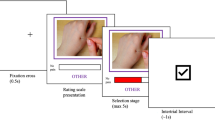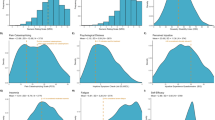Key Points
-
The study has confirmed that persons in areas of low socio-economic status are more likely to report orofacial pain.
-
Socio-economic status per se does not influence the onset of symptoms but is only a marker for a set of environmental and individual factors which may influence onset.
-
This study in examining some specific mechanical, psychological and behavioural factors has demonstrated that they cannot account for the excess symptoms amongst those living in areas of low socio-economic status.
Abstract
Study objective To confirm a relationship between self-reported oro-facial pain and deprivation using an area-based measure of deprivation, and to investigate possible mechanisms of the association.
Design A cross sectional population based survey.
Setting General medical practice in South-East Cheshire (Borough of Congleton, North West England).
Participants Two thousand, five hundred and four people aged 18-65 years living in the community.
Methods A postal questionnaire was sent which asked about pain in the oro-facial region. Information on factors which may 'explain' any relationship between pain and social class was collected: psychological distress, maladaptive responses to illness, sleep problems and local mechanical factors such as teeth grinding and facial trauma. Participants were allocated a Townsend index deprivation score on the basis of their postcode.
Main results The study achieved an adjusted participation rate of 74% (N = 2,504) and the overall prevalence of oro-facial pain was 26%. Statistical analysis revealed that people in the most deprived areas were more likely to report oro-facial pain compared with the most affluent ones [OR 1.50 (95% confidence interval 1.09, 2.07)]. This relationship remained after adjusting for all potential confounding factors.
Conclusion While the relationship between oro-facial pain and deprivation exists, the mechanisms of such relationships are not clear. Local mechanical factors, trauma or psychological distress did not explain it. The factors linking pain with social deprivation remain to be elucidated.
Similar content being viewed by others
Log in or create a free account to read this content
Gain free access to this article, as well as selected content from this journal and more on nature.com
or
References
Carstairs V . Deprivation indices: their interpretation and use in relation to health. J Epidemiol Comm Health 1995; 49 (Suppl 2): S3– S8.
Morgan CL, Ahmed Z, Kerr MP . Social deprivation and prevalence of epilepsy and associated health usage. J Neurol Neurosurg Psychiatry 2000; 69: 13– 17.
Andersson HI, Ejlertsson G, Leden I, Rosenberg C . Chronic pain in a geographically defined general population: studies of differences in age, gender, social class and pain localization. Clin J Pain 1993; 9: 174– 182.
Papageorgiou AC, Macfarlane GJ, Thomas E, Croft PR, Jayson MIV, Silman AJ . Psychosocial factors in the workplace – do they predict new episodes of low back pain? Spine 1997; 10: 1137– 1142.
Locker D . The burden of oral disorders in a population of older adults. Community Dent Health 1992; 9: 109– 124.
Vargas CM, Macek MD, Marcus SE . Sociodemographic correlates of tooth pain among adults: United States, 1989. Pain 2000; 85: 87– 92.
Townsend P, Phillimore P, Beattie A . Health and deprivation: inequality and the north. London: Croom Helm; 1988.
Prendergast MJ, Beal JF, Williams SA . The relationship between deprivation, ethnicity and dental health in 5 year old children in Leeds, UK. Community Dent Health 1997; 14: 18– 21.
Provart SJ, Carmichael CL . The relationship between caries, fluoridation and material deprivation in five-year-old children in County Durham. Community Dent Health 1995; 12; 200– 203.
Provart SJ, Carmichael CL . The use of an index of material deprivation to identify groups of children at risk to dental caries in County Durham. Community Dent Health. 1995; 12; 138– 142.
The 1991 Census Crown Copyright ESRC.
Goldberg D . Manual of the general health questionnaire. Windsor, England: NFER Publishing, 1978.
Pilowsky I, Spence ND . Manual for the illness behaviour questionnaire (IBQ). 2nd ed. Adelaide, England: NFER Publishing Australia: University of Adelaide, 1983.
McDowell I, Newell C . Measuring health: a guide to rating scales and questionnaires. Oxford University Press: Oxford; 2nd Edition, 1996.
Jenkins CD, Stanton BA, Niemcryk SJ, Rose RM . A scale for the assessment of sleep problems in clinical research. J Clin Epidemiol 1988; 41: 313– 321.
Morris R, Carstairs V . Which deprivation? A comparison of selected deprivation indexes J Public Health Med 1991; 13: 318– 326.
Goulet JP, Lavigne GJ, Lund JP . Jaw pain prevalence among French-speaking Canadians in Quebec and related symptoms of temporomandibular disorders. J Dent Res 1995; 74: 1738– 1744.
Lipton JA, Ship JA, Larach RobinsonD . Estimated prevalence and distribution of reported oro-facial pain in the United States. J Am Dent Assoc 1993; 124: 115– 121.
Locker D, Leake JL, Hamilton M, Hicks T, Lee J, Main PA . The oral health status of older adults in four Ontario communities. J Can Dent Assoc 1991; 57: 727– 732.
Tickle M, Craven R, Worthington HV . A comparison of the subjective oral health status of older adults from deprived and affluent communities. Community Dent Oral Epidemiol 1997; 25: 217– 222.
Von Korff M, Dworkin SF, Le Resche L, Kruger A . An epidemiologic comparison of pain complaints. Pain 1988; 32: 173– 183.
Acknowledgements
The authors are grateful to staff and patients of Lawton House Surgery for their help with the study. V. R. Aggarwal was supported by a Wellcome Trust entry-level fellowship and currently holds a Wellcome Trust clinical epidemiology research fellowship
Author information
Authors and Affiliations
Corresponding author
Rights and permissions
About this article
Cite this article
Aggarwal, V., Macfarlane, T. & Macfarlane, G. Why is pain more common amongst people living in areas of low socio-economic status? A population-based cross-sectional study. Br Dent J 194, 383–387 (2003). https://doi.org/10.1038/sj.bdj.4810004
Received:
Accepted:
Published:
Issue date:
DOI: https://doi.org/10.1038/sj.bdj.4810004
This article is cited by
-
Pain catastrophizing, pain sensitivity and fear of pain are associated with early life environmental unpredictability: a path model approach
BMC Psychology (2022)
-
Assessing the perceived impact of post Minamata amalgam phase down on oral health inequalities: a mixed-methods investigation
BMC Health Services Research (2019)
-
Reporting of pain by people with chronic obstructive pulmonary disease (COPD): comparative results from the HUNT3 population-based survey
BMC Public Health (2018)
-
The relationship of neighbourhood-level material and social deprivation with health-related quality of life
Quality of Life Research (2018)
-
How are socio-demographic and psycho-social factors associated with the prevalence and chronicity of severe pain in 14 different body sites? A cross-sectional population-based survey
Wiener klinische Wochenschrift (2018)



